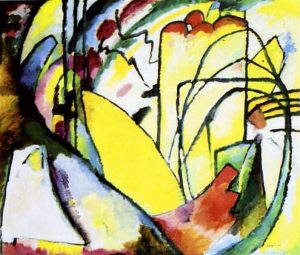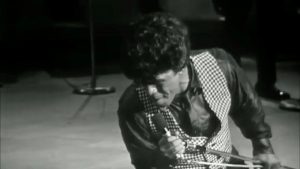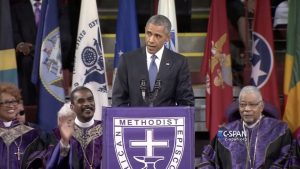Arthur Jafa’s Swing

Early in 2017, not long after the inauguration of Donald Trump as President of the United States, an artist named Arthur Jafa screened a work of video art at Gavin Brown’s Enterprise in New York City. The video was titled Love is the message, the message is death. It is about seven minutes long. It is constructed of found footage ranging in time from the immediate present to shaky clips from the early days of film. Most of the clips are just a couple of seconds long. Generally, they feature Black people, African Americans in specific. Much of the footage is upsetting. That’s to say, there are clips of police brutality against Black people. These clips are interspersed with other images not obviously related to the specific issue of police mistreatment of African Americans. The entire video is set to the music of Kanye West’s gospel-ish song Ultralight Beam.
The video piece was extremely popular, and Gavin Brown’s Enterprise noted that the gallery was especially busy during the run of the show. Many of the viewers of Love is the message spoke about its direct, emotional impact. Basically, it made people cry. That fact alone is worth noting. It is not often that one goes to a gallery of contemporary art and feels so emotionally impacted that the tears flow. Indeed, so many people cried watching Love is the message that the artwork started to become something of a global phenomenon. Museums and galleries all around the world wanted a piece of it. Interviewers and journalists wanted a piece of Arthur Jafa. As the Trump years plodded along, as well as increasingly publicized incidents of police violence against Black people that led, finally, to the widespread protests of 2020, Jafa’s video seemed ever more prescient and vital. During the summer of 2020, Love is the message was streamed simultaneously by thirteen important international art institutions, including the Stedelijk Museum Amsterdam, the Tate in London, the Palazzo Grassi in Venice, and the Smithsonian American Art Museum in Washington, DC. One immediate result is that Arthur Jafa has, in the last four years, become a major figure of the international art world. Further, this video work has had a sufficiently broad impact that it has gone beyond being an American work of art; it now has international significance.
Jafa himself remains something of an enigma. He was born in 1960 in Tupelo, Mississippi, and grew up in the area around Clarke county most associated with the great blues musicians. He went to Howard University and then became, well, it is hard to say exactly. He worked as a film editor and cinematographer. He was the cinematographer for Julie Dash’s now iconic film Daughters of the Dust. He was a cameraman for Kubrick’s Eyes Wide Shut and the cinematographer for Spike Lee’s Crooklyn. But he was never able to follow anything like a clear career path within the world of feature filmmaking. Same thing in the world of fine art. He made sculptures, produced videos and showed his art in respectable places. But he always seemed to be drifting toward the margins of whatever “world” he found himself within. A long profile in the December 21 issue of The New Yorker by Calvin Tompkins does a good job of detailing the various ins and outs of Jafa’s life leading up to the creation of Love is the message. Given Jafa’s success with Love is the message, and the overall clamor to know more about him, there are also a number of interesting interviews and talks that can be found all over YouTube.
It takes repeated viewings of Love is the message to realize that one of the reasons Arthur Jafa has never really fit either into the film world or the art world is that he’s doing something that doesn’t play by any of the established rules of creating films or video. Or, perhaps better said, it is a work that plays by other rules. More precisely still, it is a work of visual art that plays by the rules of music.
It should be said straight away that the move by visual art to take inspiration from music is not entirely new. The example that comes immediately to mind is Kandinsky. Kandinsky called many of his paintings ‘Improvisations’. He meant this in the specific musical sense of the term. He saw the colors and shapes of his abstract compositions as something like variations on a musical theme.
Jafa has, similarly, compared the structure, feel, and mood of Love is the message to jazz (a point that other critics have picked up on as well). I propose that we take this much more seriously than loose metaphor. If we want to understand what Jafa actually achieved visually in Love is the message, we have to understand something about what jazz does musically. That’s obviously a lot to talk about. Too much. But we can focus on one element of jazz in order to get the basic point. We can think of jazz as always being a matter of ‘swinging’ the note, the phrase, the line. Jazz is, at the very least, the process of taking a beat, a melody, a rhythm, and adding to it the element of swing. This did not originate in jazz. It is already there in the musical form that is the basis of jazz, the blues. So, in a sense, when we talk about this element of ‘swing’, we are talking about the fused musical form that we call blues/jazz. These are not my insights, by the way. They are the insights of people like Ralph Ellison, Albert Murray, Stanley Crouch, and Wynton Marsalis, among others. The actual experience of what swinging is can only be understood by hearing it. Explaining in words will therefore always miss the mark. But let’s at least say that you swing something musically when you add that little twist. You syncopate the beat. You add a pause. You slide or bend a note. (Here is Wynton Marsalis giving a quick explanation of what this sounds like in his discussion of the innovations in the early jazz trumpet playing of the great Buddy Bolden.) All of a sudden, a phrase of music that once trudged forward in a more or less linear manner skips or shimmies. There’s a half step and kick to the left. There’s a moment of hesitation, of not knowing when or from where or toward what the next sound will come. It is this hesitation and not-knowing from which all the great fruits of improvisation in art are born. Blues/jazz grabs onto this moment with both hands.
We’ve been taught how swinging works in music for more than a hundred years. We know that music can swing. It is an open question as to whether other forms of art, other media, can swing. One way to look at Love is the message is to see it as an attempt to do just that, to make visual images swing.
Arthur Jafa has himself said that he wants to make a form of cinema that “replicates the power, beauty, and alienation of Black music.” I think that’s why so many clips in Love is the message simply show Black people moving. Often, this movement is minimal. Just someone walking a few steps, or turning their head slightly in one direction, or shifting their body. These small bits of movement are set off from other clips where the movement is more pronounced and obvious. These are the scenes of individual Black people dancing or crowds of people dancing or moving in unison. And there are also scenes where Black people are being attacked, often by police, and here the movement becomes violent and extreme. The overall effect, though, is one of a continuity or continuum of movement. And the movement–from the subtlest nod of the head to the most intentional acts of dance or the avoidance of police attack– all of this movement could, I think, be reasonably described as swinging.
Lest we have any doubt about this matter, Jafa also throws in clips from sport. There are clips from basketball and football games where a movement is obviously motivated more by ‘swing’ than from any specific desire to achieve a goal in the game. A behind-the-back pass is not strictly necessary. It is a matter, you could say, of style. It is a flourish, a gratuitous addition of an element of beauty.
But style, in this case, is never just a matter of style. Here, style becomes a way of life, a way of moving with and against and in response to the obstacles that are put before one. Style here isn’t inessential or extra. You could say that it’s gratuitous, maybe. The extra pause, the syncopation, the swerve and the shimmy that is part of swing is always superfluous if you’re thinking only about getting from point A to point B. But swing takes it for granted that how you get from A to B matters just as much as that you get from A to B. What the images from Love is the message remind us is that this question of how can be a life-or-death matter. It can be deadly serious.
There is a great clip, for instance, of Muhammed Ali. We see just a couple of seconds of Ali bobbing and weaving as his opponent tries to land a blow. Here is the physical, the visual manifestation of swinging in pure form. Ali’s hands are down at his side. He is, potentially, opening himself to a devastating punch to the face. But it is precisely Ali’s looseness, his eyes-wide-open, subtle, shifty physical genius that allows him to avoid taking even a scratch.
Swing, you could say, is also a form of survival, as African Americans have been forced time and again to learn. Not being able to swing can have tragic consequences, as the clip of the young Black man running straight away from a policeman and then being shot in the back shows with such devastating finality.
It would be a mistake, however, to look at Love is the message as exclusively a work of political protest. It is much bigger, much more ambitious than that. There is, of course, political protest, political outrage. But Love is the message should be viewed rather more in the light of what Stanley Crouch says about jazz in the following lines from his essay “Considering Genius”:
Though the skills that make for jazz are the result of a musical evolution that probably began the moment African slaves started reordering music they heard from and were taught by the slave masters, this writer would again say that it is a dangerous simplification to hear jazz primarily as a music protesting the social conditions of Afro-Americans, even if its seminal inventors were often subjected to social limitations based on race. That reduces the monumental human achievement of a sustained artistic vision that allows for the expression of every passion, from delicate affection to snarling rage at the very demons of life at large, those tragic elements that no amount of money, power, or social exclusion will hold at bay. … No, the miracle of the improvisational art is the fact that the techniques Africans arrived with evolved into aesthetic conceptions that reinvented every kind of American music they came in contact with, from folk to religious music to dance tunes, and finally achieved the order that is jazz, where all those aspects of American musical expression were brought together for a fresh synthesis.
It is not a mistake that Crouch italicized the words ‘aesthetic conceptions’. There is an aesthetic here. This aesthetic is born of real-world situations and experiences. But all aesthetic conceptions are born of real experience. Nonetheless, once an aesthetic is born, it cannot and should not be reduced to those experiences, those conditions. The aesthetic of swing became a reality unto itself, a way of being, a particular kind of style that can be learned and passed on and understood and felt and, it turns out, transmuted into different kinds of media. Or, as Albert Murray put it in his now classic book The Omni-Americans: Black Experience and American Culture:
As an art form, the blues idiom by its very nature goes beyond the objective of making human existence bearable physically or psychologically. The most elementary and hence the least dispensable objective of all serious artistic expression, whether aboriginal or sophisticated, is to make human existence meaningful. Man’s [sic] primary concern with life is to make it as significant as possible, and the blues are part of this effort.
It is thoughts like these that make the various images and clips of Love is the message a lot easier to understand. Because there are clips (like a woman talking about how she came to realize her building was on fire) that are funny, even absurd. And there is plenty of joy expressed throughout the entire video. I think of the clip of NFL quarterback Cam Newton running toward the camera. Newton’s face is expressing, if only for a few seconds, something like pure rejoicing. Having broken free into the empty field, he is running, bounding, loping, moving in complete embodied oneness with himself. As Albert Murray would say, Newton’s life has become, for at least the few seconds in which we observe him, meaningful. Time and again throughout Love is the message we see versions of this same thing. We see Black people ‘swinging’ their movements or even speech patterns in response to the situation at hand. This is the significance, for instance, of the short clip of Barack Obama speaking before a group of Black Ministers. He doesn’t just speak the words “say praise,” he sings the words, he swings them the way a preacher would in the Black Church. Those two seconds alone say multitudes about why Obama’s presidency was important to so many Black people regardless of the specific politics of his administration.
Every clip in Love is the message is something like a tiny primer, an individual lesson in the technique of swing. But it is not just the individual clips. Jafa, through many years of practice, is a master editor. The clips themselves are put together with precise deliberation. They are strung together to subtly mimic the slowing and speeding up of the Kanye West song that accompanies them. This is not a music video, exactly. The images do not illustrate the music, it is more like a collaboration, a back and forth in which the two media are equal participants in the whole. The crucial point here is that the editing of the videos is itself an example of swing. The images bounce and shimmy and slide off one another in the same way that a great jazz improvisation does. Many of the clips resonate with one another by the similarities in the way a person holds out their hands, or falls to the ground, or smiles. These threads of similar movement hold the totality together without taking away from the individual impact of each clip.
There are also, several times within the video, shots of a cosmic entity, perhaps our own sun, though it could be any sun, any star. The star rotates as firestorms explode and ricochet from its surface in surprising ways. The point becomes clear. This question of swinging may have emerged, in our time, primarily from the aesthetics of African American experience. But swinging has cosmic import. The entire universe is, in some sense, swinging all the time. Galaxies don’t move in linear time but in bumps and shimmies and slides. Time itself is, perhaps, more akin to the sound of a jazz composition than that of a ticking clock. Or, as the physicist Carlo Rovelli explained in an interview with Krista Tippett, “When we think about time, for instance, we think time is the same for everybody. And we know it’s not true. Time passes a little bit faster in the mountain and a little bit slower near the sea; the more high you go, the more time passes fast. So it’s relative to how we move, where we are, and so on.”
The achievement of Love is the message, then, is in the curation and editing of a bunch of short video clips that express a deeper aesthetic. It is an aesthetic, call it swinging, that emerged from one particularly distinct form of African American experience. But its power and impact is not bound by any particular experience. Or to put it another way, the aesthetic that Jafa reveals to us in Love is the message, the message is death is completely particular and completely universal at the same time. It satisfies two of the oldest criteria for a real work of art that have ever been put forward: to be beautiful and to be true.





